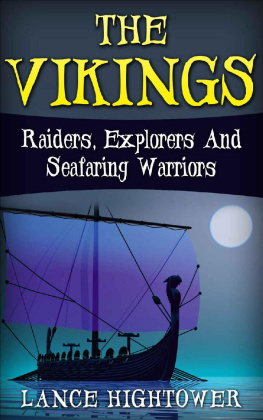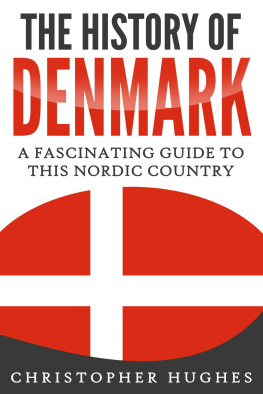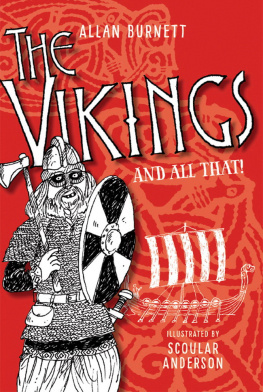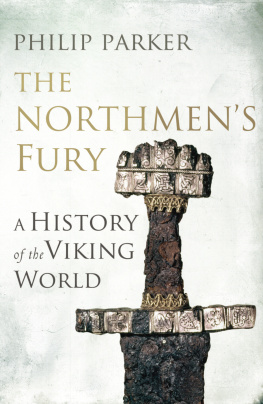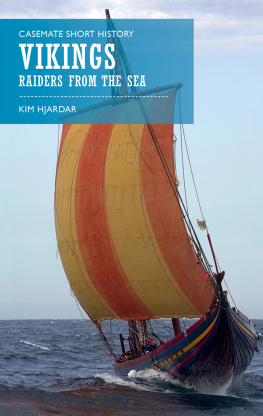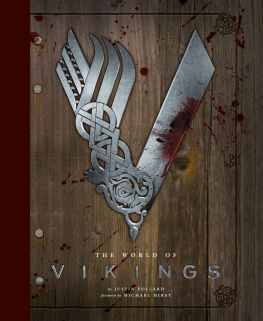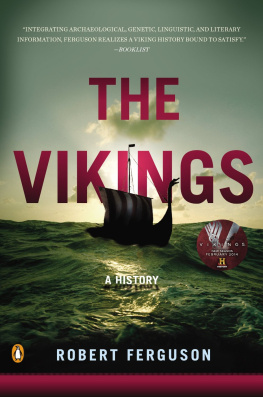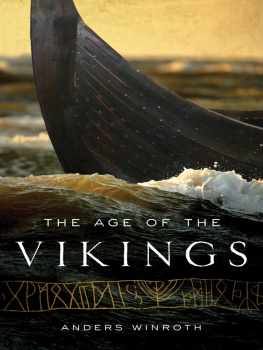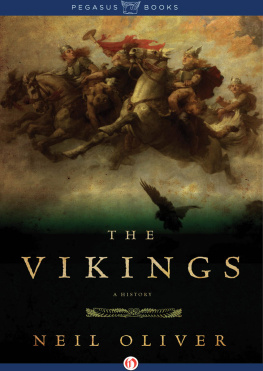THE VIKINGS
RAIDERS, EXPLORERS AND SEAFARING WARRIORS
By Lance Hightower
Copyright 2016 by Make Profits Easy LLC
profitsdaily123@aol.com
Table of Contents
Introduction
Full many a wonder is told us in stories old, of heroes worthy of praise, of hardships dire, of joy and feasting, of weeping and of wailing; of the fighting of bold warriors; now ye may hear wonders told. (From Nibelungenlied; Anonymous poet circa 1180-1210)
VIKINGS! Just hearing the name conjures images of big bold men with plaited beards in horned helmets and women in armored breastplates, fighting as one, plundering villages, defending their homeland or traveling across raging seas in dragon boats seeking adventure and wealth. But theres a lot more to the legends of the Vikings than one might suspect.
In this book, youll get a wonderful glimpse into what life must have been like for this democratic society of heathen Scandinavians: how they lived, worshipped, warred, created and expanded; where they made their homes, what they valued and why. And finally, how the Age of the Vikings came to an end.
From their ingeniously designed ships to their volatile gods and goddesses of Valhalla, from Eirik Blood-Axe to Thorfinn Skull-Splitter, the feared seamen and plunderers of the Viking Age ruled Norway, Sweden, and Denmark, then Iceland, England, Normandy, and Ireland, and roamed as far as Byzantium, Greenland, France, Russia, Spain, and North America. They were raiders, but they were also traders, settlers, craftsmen, and ingenious builders and navigators of the sea.
The history of the Vikings never seems to lose its capacity to captivate us today in much the same way as the original Viking warriors struck fear in the unsettled world of their own time. From the first documented raid to the Vikings last stand, this is not a dry history, but a thought-provoking and often electrifying look at the lives, deaths and events that made the Vikings the formidable culture they were.
Editors Note: All text in italics is directly quoted from translations of ancient literature. Text in quotations are a summary of portions of stories from ancient poetic literature. Text in [brackets] has been added to quotes and translations by the author for clarification.
Chapter 1: The Age of the Vikings: AD 790 to 1115
He who lives without discipline dies without honor. Icelandic Proverb
So who were the Vikings and how did they become what they were and what they continue to be in our memories? What made these people stand out from all the rest of the warring peoples around the globe?
A lot of the Viking legend and its place in history has been misinterpreted because what we know about them comes from Skaldic and Eddic poetry, known as sagas, written as long as 300 years after the end of the Viking Age, and in many cases, by family members who may have embellished the feats of their ancestors. From those translations of the old writings, and from original Viking runes and other archeological findings, historians have been able to piece together a comprehensive picture of the world of the medieval Scandinavians known as the Viking Norsemen, but it has often been difficult to discern fact from fable.
Poetic sagas may be prejudiced because they are intimately bound up with family and genealogical background. For example, in Islendingabok (The Book of the Icelanders), the author exaggerates the importance of the deeds of family members, and in Heimskringla (The Lives of the Norse Kings), claims to political power and the significance of the authors own ancestors cannot be taken as completely accurate. Like all history, however, its fluidity is developed as historians and archeologists unearth new material or create different perspectives.
So the construction of history written by authors who wanted to flatter their ancestors, along with the popular modern media of television and film, and even 19th century writings such as the Lord of the Rings has compromised history to some extent, but the original Sagas offer the best account of events and their causes taken in context.
Additionally, sophisticated techniques such as numismatic analysis, dendrochronology, which permits highly accurate dating of wooden objects by tree-ring analysis, archeo-zoology, paleo-botany, DNA analysis, ice crystallography, and climate analysis have given us considerable information to make up for any loss in translation and literary conversion.
Who Were the Vikings?
Hail, All Father, wise warrior, one-eyed wanderer. Come sit at my fire and tell me your wisdom stories. You who chooses the slain, when my time comes to run the sky with you, let my end be worthy of song.
The Viking Age is an often misunderstood and complicated period in history, and it has been written about mostly in broad strokes, but the popular image of these independent people is often seen as one of marauding warriors who pirated the seas and plundered villages and holy places, burning everything and taking the spoils and resources for themselves. They did indeed pillage their way along the shores of Northern Europe and beyond, but Norse society at home was one of the first democratic states, and as you will see, the Vikings were not only ingenious builders, they had a great deal to do with the development of Britain and the expansion of Christianity beyond the British Isles.
Before we get into how they became known as the Norsemen, the legend weve come to know, it will be helpful to understand something about Viking names to lessen any confusion. In those days, men were named for their fathers. The names are patronymic, theyre not family names as we know them where the same surname is carried on to each generation, both male and female.
A man would be addressed by his first name. For example, Leif Eriksson was called Leif, and any attribution was added to that name - Leif the Lucky. His surname would be his fathers first name. Leif was the son of Eirik Thorvaldsson, so Leif Eriksson was Leif, Eiriks son.
Eirik Thorvaldsson (Eirik the Red) was the son of Thorvald Aswaldsson, the son of Asvald Ulfsson, the son of Ulf Oxen-Thorisson, the son of Oxen-Thorir, and so on. Here is where they begin having only one name. So you can see how each successive generation took the name of the one before.
Oxen-Thorir > Ulf Oxen-Thorirsson > Asvald Ulfsson > Thorvald Asvaldsson > Eirik Thorvaldsson > Leif Eriksson.
Oxen-Thorir: This name would have been written as rir and was a given male name. The word oxen before his given name would have to do with his occupation, pastime, an outstanding physical quality, or a particular temperament for which he might have been known. Oxen-Thorir was the brother of Naddodd, the discoverer of Snaeland (Snowland/Iceland), and this is where the story of the men who would eventually become known as Vikings begins.
The Beginning of the Viking Age
Better it is to die in battle with honor than to live in shame because you did not defend your people. Bjarnar Saga, Htdlakappa
The Viking Age began with raids by these heathen Scandinavians on Christian targets in the British Isles in 793 and is contained within the Germanic Iron Age, sometimes called the Merovingian Period after the Frankish Merovingian dynasty that was the dominant power in Europe from about 460 to 751. The term Viking Age within the Iron Age was created by historians for the large number of seafaring raids by Scandinavian warriors that had taken place over more than 300 years and were recognized for their importance in cultural history.
One of the most often told accounts in history, and one which paints a picture for us of the mindset of these people, has to do with the feud between Eirik Thorvaldsson and his neighbor, a man called Thorgest, and it sets the scene for the development and expansion of these sea-faring people.
Next page
